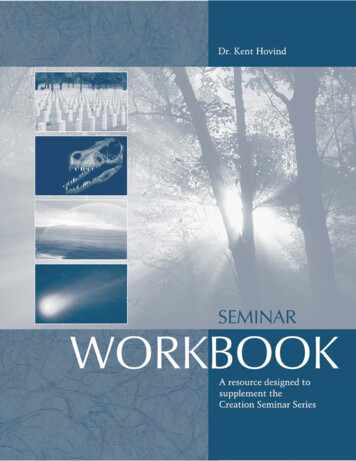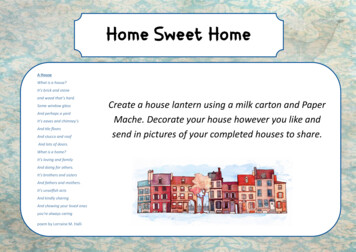
Transcription
INTRODUCTION TOBOTANY9
TEXTBOOK TABLE OF CONTENTSTEXTBOOK LESSON 1LAB SUPPLY LISTJUNIOR NOTEBOOKING JOURNAL SAMPLEREGULAR NOTEBOOKING JOURNAL SAMPLEFREQUENTLY ASKED QUESTIONSTHIS IS A PREVIEW. THE NUMBER OF PAGES DISPLAYED IS LIMITED.
TABLE OF CONTENTSINTRODUCTION TO BOTANY. 9LESSON 1:WHY BOTANY MATTERS?.13Welcome.14Creative Creator.16Nature Journaling.17Activity 1.1: Think Like a Scientist.18Activity 1.2: Make a Nature Journal.19Using Your Nature Journal Likea Scientist.19Activity 1.3: Journal About Nature.21Science of Botany.21Activity 1.4: Observe Leaf Veins.25Activity 1.5a: Observing Absorption.25Activity 1.5b: Walking Water Without aVascular System .26Activity 1.6: Go on a Nature Hunt .27To Seed or Not to Seed.27Seedless Plants.28What Do You Remember?.28Activity 1.7: Grouping Plants .29Activity 1.8: Make a Light Hut .29Activity 1.9: Grow Edible Plants .30LESSON 2:SEEDS.31Sleeping Seeds.32Testae. 33Activity 2.1: Design a Seed.34Activity 2.2: Examine Your Seeds.35Anatomy of A Seed.35Activity 2.3: Identify Dicots and Monocots.37Germination.38What Do You Remember.39Activity 2.4: Label the Parts of a Seed.39Activity 2.5: Compare GerminationConditions.40LESSON 3:ANGIOSPERMS.43Flowering Plants.44Activity 3.1: Disect a Flower.46Activity 3.2: Label a Flower.49Activity 3.3: Walk in Nature.49Flower Families.50Activity 3.4: Plant a Sunflower.51Think About This.53Activity 3.5: Label an Orchid.54Flesh Eating Flowers.55What Do You Remember?.58Activity 3.6: Design a Flower.59Activity 3.7: Preserve a Fresh Flower.59LESSON 4:POLLINATION.61Pollination.62Think About This.63Bees.63Other Insects.67Activity 4.1: Explore FlowerPollination.68Bird Pollinators.68Activity 4.2: Build a HummingbirdFeeder.69Mammal Pollinators.70Activity 4.3: Illustrate AnimalPollinators.71Wind Pollination.71Why Most Flowers Don’tSelf-Pollinate.72Self-Pollination.73The Pollinated Flower.73What Do You Remember?.74Activity 4.4: Illustrate What You Learned.74Activity 4.5: Create a Comic Strrip.74Activity 4.6: Make a Butterfly Garden.75Mov
LESSON 5:FRUIT.77A Flower’s Fruit.78Fruits and Veggies.79Fruit Kinds.79Activity 5.1: Observe Insects ona Banana.80Activity 5.2: Catagorize Fleshy Fruits.81Activity 5.3: Split a Squash.82Think About This.82Dry Fruits.83Activity 5.4: Find and Illustrate Fruits.84Seed Scattering.85Activity 5.5: Examine Burrs.88What Do You Remember?.91Activity 5.6: Discribe Seed Dispersal.91Activity 5.7: Preserve the Color of Fruit.92LESSON 6:LEAVES.93Leaf Mouths.94Making Food.96Photosynthesis.97Sunshine Energy.97Activity 6.1: Burn a Candle in a Jar.98Color-Fill.98Activity 6.2: Block the Sun.99Activity 6.3: Sprout Potatoes.100Transpiration.100Activity 6.4: Test Transpiration.101Falling Leaves.102Activity 6.5 Preserve Leaf Color.103Anatomy of a Leaf.103Simple Leaves and Compound Leaves.104Leaf Arrangement.104Leaf Venation.104Leaf Shapes.105Leaf Margins.107What Do You Remember.107Activity 6.6 Illustrate the Anatomyof a Leaf.107Activity 6.7 Make a Leaf Storybook.108Activity 6.8 Collect Leaves.108viLESSON 7:ROOTS.109Good Soil.110Nutritious Soil.111Activity 7.1: Make a Quick Compost.112Root Hairs.114Root Growth.114Preventing Erosion.115Floating Roots.116Geotropism.116Activity 7.2: Discover Geotropism.117Root Systems.118Geophytes.118Rooting.119What Do You Remember?.120Activity 7.3: Illustrate Roots.120Activity 7.4: Classify Roots.121Activity 7.5: Clone Vegetables ThroughRooting.121LESSON 8:STEMS.123Plant Structure.124Activity 8.1: Explore Xylem .125Woody and Herbaceous Stems.126Activity 8.2: Draw Woody andHerbaceous Stemmed Plants.127Succulent Plants.128Auxins.128Activity 8.3: Imitate Phototropism.129Examples of Phototropism.129What Do You Remember?.130Activity 8.4: Color a Flower.130Activity 8.5: See Auxins in Action.131
LESSON 9:GARDENING.133Your Edible Garden.134Gardening Power.134Better Foods.135Activity 9.1: Create a Garden Journal .136Activity 9.2: Plan Your Garden .136Tools for Gardening.137Raised Bed Garden.137Location.138Building Your Bed.138Width and Length of Garden.138Activity 9.3: Build Your Raised Bed .139Soil .139Mixing Your Soil.140When to Plant.140Image of USDA Hardiness Map.141Growing Seasons by Zone.141What to Plant When.142Activity 9.4: Journal Your Plan .142Planting Seedlings.142Spacing Plants.142Tall to Small.143Activity 9.5: Map Your Garden.143Watering Your Garden.144Activity 9.6: Make an IrrigationSystem.144Maintaining Your Garden.145Fall and Winter Ideas.148What Do You Remember.149Activity 9.7: Draw Your Garden.149LESSON 10:TREES.151Trees are Special.152Trees are Important.153Activity 10.1: Identify Things MadeFrom Trees.153Animal Shelter.153More Tree Facts.155Activity 10.2: Plant Some Trees.155Seed Making.155Tree Growth.156Twig Anatomy.157Activity 10.3: Measure Twig Growth.158Activity 10.4: Estimate the Height ofa Tree.158Growing Outward.159Tree Trunks.160Trunk Layers.160Tree Bark Patterns.161Activity 10.5: Make a Bark Rubbing.161Thirsty Trees.162What Do You Remember?.162Activity 10.6: Diagram a Tree’sLayers.163Activity 10.7: Make a Tree FieldGuide.163vii
LESSON 11:GYMNOSPERMS.165Uncovered Seeds.166Conifers.166Activity 11.1: Measure GeneralSherman.167Activity 11.2: Compare Transpiration.169Activity 11.3: Identify and IllustrateLeaves.170Cycads.172Ginko Biloba.172Forests.173Forest Fires.175What Do You Remember.176Activity 11.4: Write a BristleconePine Story.176Activity 11.5: Opening and ClosingPinecones.176LESSON 12:SEEDLESS VASCULAR PLANTS.177Sporangium.178Fern Anatomy.179Fern Lifecycle.180Pteridomania.182Activity 12.1: Create Fern Artwork.183Type of Ferns.184What Do You Remember?.185Activity 12.2: Illustrate a Fern.185Activity 12.3: Build a Small FernTerrarium .186LESSON 13:NONVASCULAR PLANTS.187Brophytes.188Mosses.189Uses for Mosses.189Liverworts.191Activity 13.1: Hunt for Moss andLiverwort.192Lichens.192What Do You Remember?.195Activity 13.2: Illustrate the MossLife Cycle.195Activity 13.3: Build a Lichenometer.196Activity 13.4: Create Moss Graffiti.197viiiLESSON 14:MYCOLOGY.199Fungi.200Consumers.201Fungus Among Us.201Yeasts.201Activity 14.1: Experiment with Sugarand Yeast.203Molds.204Activity 14.2: Test MoldEnvironments.206Mushrooms.207Mushroom Lifecycle.208Dust in the Wind.211Spore Dispersal.212Saprotrophs.212Fairy Rings.213Parasitic Mushrooms.213Mycorrhizal Mushrooms.214What Do You Remember?.214Activity 14.3: Mycorrhizal MissionStory.215Activity 14.4: Hunt Mushrooms.215Activity 14.5: Grow EdibleMushrooms.216APPENDIX.219Supply List.220Answer Key.223Index.231Photo Credits.237
THIS IS THE START OFTEXTBOOK SAMPLETHIS IS A PREVIEW. THE NUMBER OF PAGES DISPLAYED IS LIMITED.
LESSON 1WHY BOTANYMATTERS
LESSON 1digging deeperThen God said, “Let the earth producevegetation: seed-bearing plants and fruittrees on the earth bearing fruit with seedin it according to their kinds.” And it was so.The earth produced vegetation: seed-bearingplants according to their kinds and treesbearing fruit with seed in it according to theirkinds. And God saw that it was good. Eveningcame and then morning: the third day.Genesis 1:11–13WELCOMEAll animals that live in the rainforestdepend on plants for survival.As you embark on this year’s science course, discovering the secrets of all God created on the third day,remember that the Earth is the Lord’s and everything belongs to Him—including you!Your journey into the wonderful world ofbotany begins right here, right now. All that youlearn this year will be important for the rest of yourlife. Why? Well, let’s find out.Botany, as you probably know, is the studyof plants. It is one of the most important fields ofscience in the whole world. Why? It’s because ourvery survival depends on plants. You see, plantsproduce the air we need to breathe, the food wemust eat, the medicines that make us well, andmany other items we use every single day. In fact,this book you are reading is made from plants! Andlet us not forget that plants also make Earth a morebeautiful place to live. Imagine a world withoutany plants. What would you eat? Think about that.Did you know that virtually everything you eat iseither a plant or something that depends on plantsfor survival?Think about pizza, for example. Every partof a pizza requires plants to exist. The crust is madefrom wheat. The tomatoes sauce is made from the14Humans are dependent on the food crops that farmersgrow such as this orange grove.
LESSON 1fruit of the tomato plant. Several other fruits and vegetables add to the taste and flavor. But what about thepepperoni? It’s made from pork and beef. Pork comesfrom a pig, and beef comes from a cow. Well, can youguess what pigs and cows eat? Plants! Without plants,there is no pork or beef. Indeed, almost every animalyou eat—such as a chicken and fish—lives on plants.Of course, some people eat alligators, frogs, and such.However, even though those animals eat other animals, the animals they eat actually live on plants. Soit all comes down to plants. We need them. And weshould learn as much as we can about them because theyare a vital part of life on Earth.This pizza could not exist without plants.By understanding the secret worldof botany, you’ll become an expert on whatit takes to grow and nourish plants and helpthem flourish in this world. When you’redone with this first lesson, you will createa special structure called a light hut that’sdesigned to grow plants from seeds any timeof the year. You can plant any seeds you want,but I recommend herbs if you’re starting inthe fall because herbs can be grown indoorsthrough the winter. If you are beginningin the spring, plan for fruits and vegetablesHerbs are easy to grow indoors and can be used for cooking.because you’ll be planting an edible gardenoutside! That means you’ll grow food likestrawberries, blueberries, carrots, pumpkins, tomatoes, lettuce, and so much more. If youlive in the southern United States and are starting this book in the spring, you maywant to go directly to Lesson 9 to begin building your outdoor garden.In addition to these important projects, you’ll do experiments, dissections, activities, and much more. As you can see, you’re going to learn a lotof important information this year, and I’m quite certain you’ll be a brilliantbotany student by the end of this course!But botany isn’t all we have planned for this year. In addition tolearning about plants, you’ll also learn about fungi (fun’ jye). What on earthare fungi? Have you ever seen mushrooms growing outside? They are fungi.Because fungi also grow outdoors alongside plants, sometimes even helpingplants, we’re going to take one lesson to dive into the fascinating world offungi. I think you’ll find this special creation of God quite interesting.This mushroom is a fungus.15
LESSON 1CREATIVE CREATORGenesis 1:11–13 tells us that God created plants onthe third day of creation. And boy oh boy, did He doan amazing job! In fact, we might say that plants trulymagnify the Lord. Are you wondering what it meansto magnify the Lord? Have you ever looked througha magnifying glass? A magnifying glass makes thingslook bigger so we can see them better, and that’s exactly what God’s beautiful world does. It magnifies Godso we can see Him better. When we study the flowers—their beauty and how perfectly they were created—we know that God is also beautiful, perfect, andcreative. But of course our Creator is creative! He usedunbelievable imagination when creating Earth. Didyou know that God even gave you the gift of creativityJust as you do when you create things,when He designed you in His image? Do you have anGod cares about His creation.imagination? Of course you do! You were made in theimage of God. Did you know that it magnifies God when you do creative things? It certainly does.That’s because you’re using the gift of creativity He gave you. What are some creative things you liketo do? Do you like to draw pictures, tell stories, or build things? Do you imagine new adventures ordesign new ways of doing things? Don’t ever forget that God loves you and specially designed you withyour own unique way of expressing your creativity.In addition to creating the wonderful person that you are, God created so many different andamazing kinds of plants. In fact, there are thousands of unusual plants in God’s kingdom. For example,some plants capture insects or small creatures and consume them for food. One kind of plant grows aflower that’s three feet long (probably as long as youare) and smells like rotten meat. Some flowers lovethe sun so much that they turn around throughoutthe day to always face it. Other flowers don’t like thesun, staying closed during the day and opening onlyat night. A few flowers are specially designed foronly one single kind of animal to drink their nectar.God even created flowers that look like animals. Didyou know that a special tree in Madagascar drinks inwater, storing it in its trunk like a giant water bottle?God created some trees to grow so tall they seem toreach the sky. Would you be surprised to learn thatthe oldest living thing we know of on Earth is actually a plant?You can see from this Madagascar tree’s swollen trunk why it’snamed the water bottle tree.16
LESSON 1The design of these flowers is perfectfor giving the hummingbird food.As you journey through this book,you’ll learn about soil, seeds, roots, leaves, flowers, creatures that help plants grow, trees, andso much more. You’ll do projects like create aminiature indoor greenhouse (the light hut Imentioned earlier)and make a field guide ofplants in your area. You’ll do experiments withplants, like changing the color of flowers. You’llalso record what you learn in your BotanyNotebooking Journal. Very soon, you’ll makea special book called a nature journal and, likea true scientist, you will record your scientificobservations of the outdoor world on its pages.I think you’ll enjoy digging into the naturalworld of plants and fungi, don’t you?Now let’s learn about nature journalingand get started on our scientific studies.Birds will feed on the nectar in these bleeding heart flowers.This cradle orchid is sometimescalled a swaddled baby orchid.NATURE JOURNALINGThroughout history scientists, naturalists, inventors, andexplorers have kept detailed accounts of what they see,experience, wonder about, and learn. Most of these peopleput their thoughts, ideas, and observations in a special bookcalled a log or journal. Much of what we know about theworld today we’ve learned from these scientists and explorers who shared their books with us. People such as Leonardo da Vinci, Lewis and Clark, Alexander Graham Bell, andJames John Audubon left us amazing journals filled withtheir drawings and writings. These recordings have taughtus a great deal about nature, inventions, territories, cultures, and human beings. We see from their journals howthey took the time to study with great care what they saw.Leonardo da Vinci made many kinds of sketches in his notebooks,from technology and animals to human anatomy. This is a page from oneof his notebooks.17
LESSON 1Usually, when we go outside, we don’t take time to focus on the details around us. But if we do this,we will learn the skills of observation that gave them such great insight.Like many great scientists from the past, you will keep a journal this year. It will be a naturejournal. To start, let’s try an activity that will help you become more observant so you will be a betternature observer and nature journalist.ACTIVITY1.1THINK LIKE A SCIENTISTGo outside in nature and begin looking around. Notice a plant asyou walk past it. Take a leaf from that plant and look at it very closely. Notice its shape. How does it feel? Is it soft or hard? What coloris it? Do you know what color it will be in another season? Do youknow if it survives through the winter or if it will fall from the plantand die? How big is it compared to other leaves? What kind of plantdoes it grow on? A tree, a bush, a vine? Think about the answers tothese questions and come up with other questions about it. Makeyour own unique observations about this particular leaf. If you havea magnifying glass, see if there is anything more to observe that youdidn’t notice when looking with your naked eye. Save your leaf forthe next activity.During the last activity, were you surprised at how much detail there was in that single leaf? Do younow see the plant a bit differently, understanding a little more about it than you did before? Even ifyou don’t, that activity helped you observe a leaf the way a scientist does. You were training your eye tosee and your mind to think critically, with more attention to detail, just like a scientist. That’s what wewill be doing a lot of during this course. By keeping a nature journal, you’ll spend some of your timeoutdoors thinking hard about what you see. Instead of frolicking around the whole time, playing andenjoying the outdoors like a child, you’ll take some time to enjoy the outdoors like a scientist.So what exactly are you going to do with your nature journal? You’ll take it on walks and hikes orto botanical gardens and nature nurseries. This journal will become your very own record of the thingsyou see in nature—the plants and animals you find interesting.The next time you are outdoors, I want you to slowdown and pay close attention to what is around you. You’ll betraining your eyes to see, teaching your ears to hear, and schooling your mind to be still so you can notice the smallest detailsaround you. It’s when you begin to really see the elements ofnature that you start thinking like a true scientist! After lookingcarefully at nature, you will begin recording your observations.18
LESSON 1You will need: ACTIVITY1.2MAKE A NATURE JOURNALCover paper (construction paper, colored card stock, or scrapbook paper)Copy paper (10–12 sheets)StaplerStack of cardboard (or substitute a kitchen cutting board)You will do:1. Stack your copy papers on top of the cover paper.2. Fold the papers in half and make a crease down the middle.3. Turn the pages over and lay them flat on top of the cardboard stackwith the cover paper facing upward.4. Open the stapler and position it so that the staples will align withthe crease in the center of the cover paper.5. Staple three or four staples down the center of the papers to createthe journal.6. Pull the journal off the cardboard.7. Turn it over so that the inside middle pages with the staples arefacing upward. Ask an adult to flatten the staples in the center (Youcan use a butter knife to aid in this).8. Decorate the cover however you wish. You may want to glue theleaf you studied earlier to the cover or make a drawing of it.9. After you fill this journal with your thoughts and observations, justcome back and make another one!10. You will create a special pocket to store your nature journal insidethe cover of your Botany Notebooking Journal.USING YOUR NATURE JOURNALLIKE A SCIENTISTILLUSTRATIONS, SKETCHES, AND DIAGRAMSIllustrations are drawings. You can illustrate a part of something you see, such as a petal. Or you canillustrate the whole plant, or even the entire scenery, such as a waterfall and all the rocks and treesaround it. Don’t forget to bring a set of colored pencils for your illustrations. It might be helpful to geta book on how to draw. This will help improve your illustration skills more quickly.19
LESSON 1Sketches are a little different from illustrations. They are often drawn quickly with only a pencil. You can also diagram what you observe, including labels with lines and arrows pointing to differentparts of your sketch.DATE,TIME, PLACE, AND WEATHERThe most important information to put on each page of your journal is the day, the time, and the placewhere you are observing nature. Be sure to include the time of year, the temperature, and what the weather is like that day.Remember, good science begins by asking questions. This will be your first scientific inquiryfor this course. It is my hope that sometime during this course you will discover the answers to yourquestions and learn secret things about the plant world that you didn’t know before.SPECIMENSVery occasionally, and with your parents’ approval,you can include in your nature journal samplesof the leaves and bits of nature you find outdoors(as long as they are not too bulky). However, becareful not to disturb too much of nature whentaking a specimen. You wouldn’t want to removethe only flower in a field. You could disrupt thenatural cycle of that plant’s growth.Press flowers for several days between two heavy books toflatten them before adding them to your nature notebook.DESCRIPTIONS AND THOUGHTSIn their nature journals, scientists make detailed notes about what they see. They observe things carefully and notice small changes and differences in nature. In order to journal like these scientists, you’llneed to make yourself think very carefully, asking questions about what you are observing. Is there anything special about the plant or animal that you notice? What does it look like? Does it have any specialfeatures that seem interesting or different from other plants or animals? If it is a plant, can you describethe shape of the leaves, the look of the stem, or the number of petals on the flower? What color is it?Look at it through a magnifying glass. Describe what you see in your journal. You may also want towrite down what you think about while you are outside in nature.What can you note about the day, the weather, or the time of year?LISTSSometimes it is helpful to make lists of things you see in nature.Simply write down every kind of tree you see on your nature walkthrough a certain park or record the name of every bird that comesinto your backyard on a particular day.Your lists will prove to be an interesting and importantaspect of scientific study. With lists, you can begin to notice thingsthat change in your area. Perhaps you remember always seeing acertain flower or bird in the spring, but later on you notice thatit isn’t present anymore. These are the kinds of observations thatgenuine scientists make.20
LESSON 1ACTIVITY1.3JOURNAL ABOUT NATUREGo outdoors and spend some timeclosely studying the plants in youryard. Be sure to ask lots of questionsas you consider what you are seeing.Even if you don’t know the answer,questions are a great way to beginthinking like a scientist. When youfind something that seems interestingto you, illustrate it and write aboutit in your nature journal. Be sure torecord the date, time, and place whereyou observed it.SCIENCE OF BOTANYYou are certainly off to a great start in your science studies this year. I hope you are getting the knackof closely observing nature and recording your findings in your nature journal. Let’s talk a little moreabout the science of botany.VOCABULARY OF BOTANYAs it is with all sciences, you will learn the s
life. Why? Well, let’s find out. Botany, as you probably know, is the study of plants. It is one of the most important fields of science in the whole world. Why? It’s because our very survival depends on plants. You see, plants produce the air we need to breathe, t











